Where have all the sisters gone?
Nearing the end of the 20th Century, adult Catholics educated in the parochial school system or had their tonsils removed at a local Catholic hospital began to wonder, where are the sisters? What had happened to the habited women who had so generously served, often without pay, in both these nation-wide systems? Was it simply the fact that many no longer wore the distinctive medieval garb? Or was something else going on?
Indeed, the times were changing. Throughout society, opportunities for women in general were expanding often pushed by growing access to higher education. Ever so slowly, ability, rather than gender, was becoming the important criterion for any impactful career. These gradual changes opened up opportunities for service to women who hadn’t necessarily sensed a call to religious life. As things shifted, the numbers of sisters in religious communities began to decline throughout the country. Many women who had entered to serve, saw intriguing possibilities outside of the convent opening up for them. Following Vatican II, others realized that marriage and family life also were important vocational calls to holiness.
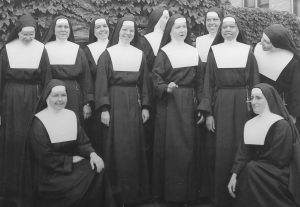
First profession class ’57. Back row third from left: Sisters Pauline Feiner, Beverly Heitke, and Rita Barman. Back row second from right: Sister Virginia Honish. 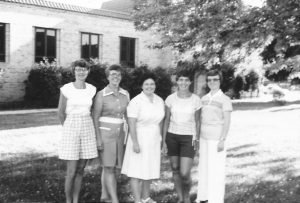
July 1979 reunion of 1957 class. From left: Sisters Rita Barman, Virginia Honish, Florence De Mers, Pauline Feiner, and Beverly Heitke. 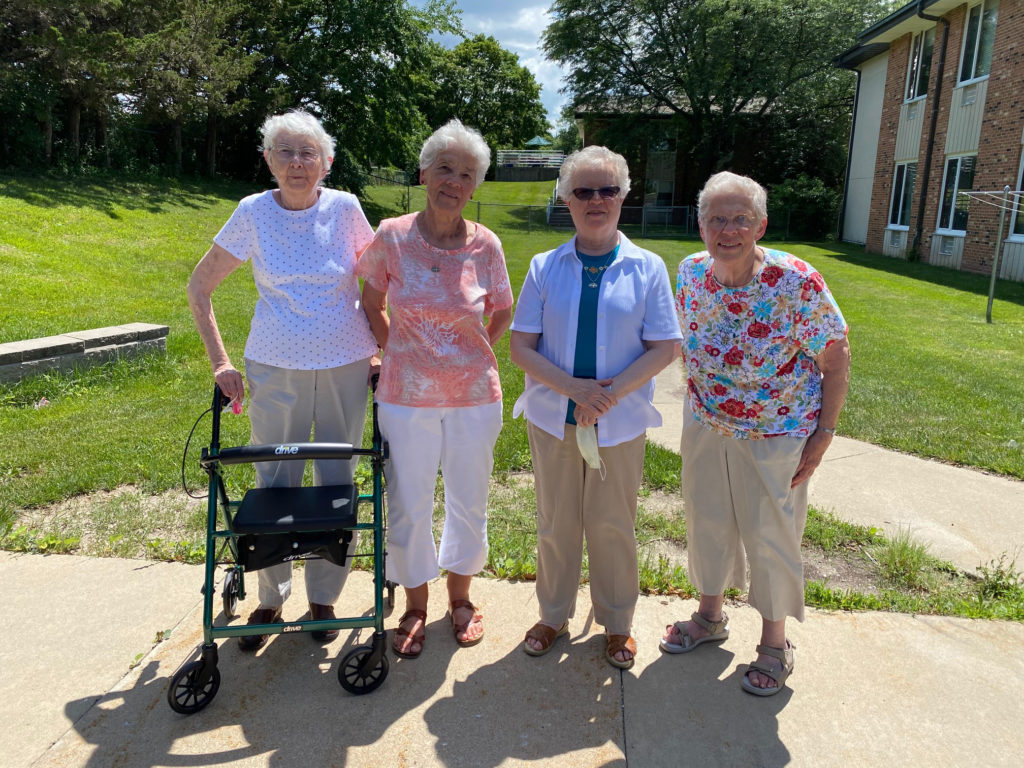
Sisters Rita Barman, Pauline Feiner, Beverly Heitke, and Virginia Honish in summer 2020
Our Salvatorian Community, along with other congregations in the United States, experienced the turbulence brought on by these “sea changes”. Young women who had entered the convent with 20 some classmates, often found themselves in groups of 2 or 3 or even alone when they professed their final vows. As we look back, the question arises: Why did they stay when so many others were leaving? We invite you to take a few moments to read the way a number of our sisters have continued to answer that important question.
Click here for Sister Carol Jean Zais’s Answer
Over the years I have often pondered, “Why did I stay?”
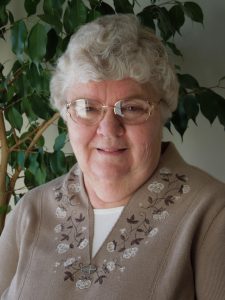
I will be honest … it was very difficult to see so many of my classmates and friends leave. Sometimes I would ask myself, “Should I be leaving too?” I had grown close to so many who left. The beauty of it all is that I still remain close with many of my classmates. We have met very often over the years to share our memories and catch up on each other’s lives. We have been friends for over 60 years! We have great respect for each other and do not question the choices we made.
So, why did I stay? I stayed because I continued to experience God’s call to live and serve as a Salvatorian. I was happy in my choice of religious life. Sure, there were ups and downs, but I loved my ministry in education and parish life. God was close and present in all the students and staffs I ministered with. I found community life fulfilling, and prayer was an important part of my life. God’s call has remained with me, and I’ve been supported by many wonderful friendships through the years.
Click here for Sister Mary Lee Grady’s Answer
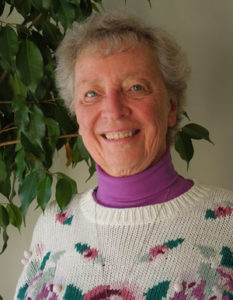
In the late 1950s it was quite common for larger groups of young people to enter religious life. I was one of those young people. When I became a candidate in our community, I was among seven others from my Divine Savior High School (DS) graduating class. Today, three of us remain Salvatorians, two professed sisters and one Lay Salvatorian. Over the years, the others moved on to different vocations. So why did I stay when my friends were leaving? Each time one of my friends left, I would rethink why I stayed. I entered because I wanted to be a teacher and do “something” in the church. I thought that being a sister would be a way to accomplish those two goals, perhaps not the loftiest reason. I also loved the Salvatorian Sisters I had as teachers at DS and the joy they always showed, along with being excellent teachers and mentors. I stayed back then and remain today because I grew in awareness of what my vocation actually was and is … a special gift from God. It’s a way to grow in love for God and others through the blessing of a variety of ministries. I continue to live in this blessing every day, and thank God for the gift of a vocation to Salvatorian life.
Click here for Sister Pauline Feiner’s Answer
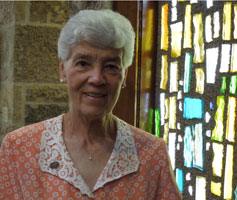
I stayed when many other sisters were leaving because I was convinced that religious life was the right path. My commitment felt right and good for me. I was attracted to a life of service and really admired my Salvatorian teachers and mentors. They were an inspiration to me and I wanted to be like them. It’s been a fulfilling and happy life for me and I have no regrets. My decision was right for me back then and it still is!
Click here for Sister Jane Eschweiler’s Answer
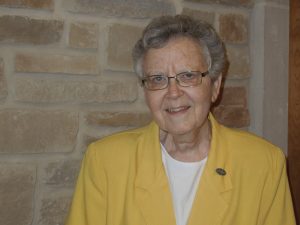
I had felt the call very early on, back in the ‘50s. My folks both had sisters in the convent, and my dad had three brothers who became priests! So I had six aunts and uncles who were religious, and all stayed. They would be around on holidays and sometimes we would drive to visit them at their places of ministry on a Sunday. I liked their service-driven lives. They seemed happy, and it looked like their lives had meaning. I wanted to do like them — make a difference. STUFF didn’t appeal to me much — save for my brownie camera and bicycle — and I wasn’t boy-crazy. Being of German heritage, I did not chafe at the structure of religious life.
We lived one block from Mother of Good Counsel, a Salvatorian parish. I went to school there and was taught by Salvatorian Sisters all through grade school. Then I entered the prep school and again was taught by SDS at DSHS. There was a natural affinity for SDS, as we grew up near their house and saw them up-close each day. They took me under their wing and I helped in the sacristy and classrooms.
Click here for Sister Patrice Colletti’s Answer
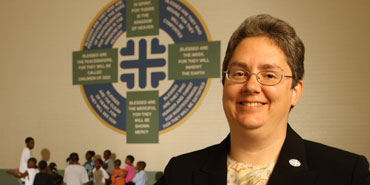
From the very beginning of my formation, I learned that “no one knows what the future will look like.” I simply accepted that fact. I came to the Salvatorians as our sisters were completing revisions to our Rule of Life, launching many ways of collaboration with the Society of the Divine Savior priests and brothers, and as our Team Leadership model was maturing. These changes presented the reality that nothing was going to remain the same. I accepted and embraced this shape of religious life.
Also, I never experienced large numbers of sisters, nor the “exodus” post-Vatican II. Having not gone to Catholic schools until college, I didn’t really know much about sisters or Vatican II. Everyone who left post-Vatican II had already done so by the time I entered.
I will admit, changing religious names back to baptismal names was a bit confusing — for about 10 minutes — and then it became a part of history for me. Sr. Grace Mary, my formation director, fielded MANY questions from me during my formation. Then, as now, I seek to understand WHY something was done — or not done. In this particular case, I had no desire to change my name. Having to wear a navy blue polyester skirt and blazer was traumatic enough for me! I would rather have worn a tee shirt and jeans with hiking boots or sneakers! (Still would, actually.) So much for “the habit” question!
Since the shape of religious life and how we live our SDS charism was always framed by “we don’t know what it will look like in the future,” the many changes that have occurred during my time have not been scary or threatening. I honor the deep feelings some of our sisters have about changes such as the habit, sponsored institutions, decision-making and discernment processes, media stereotypes, and the evolution of our Salvatorian Family, but they’re not my feelings. After all, many of them entered religious life assuming it would pretty much stay the same for the rest of their life. I come from the opposite understanding, that nothing would look the same, so “stretching” oneself to make those changes would be the norm.
One other thought on the “exodus” of sisters: When we celebrated the 100th anniversary of our founding, I recall a decision to invite former members to celebrate with us. It left a positive impression on me. So, too, has the fact that some of our most active Lay Salvatorians were former sisters, priests or brothers. The evolution of our Lay Salvatorians has also been the “norm” for me. There simply wasn’t a time in my life as a Salvatorian that we weren’t already a “family” of three equal branches. It impressed me during my initial formation and in my vows ceremonies, which were collaborative. I remain impressed by the ongoing transformation in our Salvatorian Family. It is so much in line with our history, and is also still MAKING history.
Click here for Sister Ellen Sinclair’s Answer
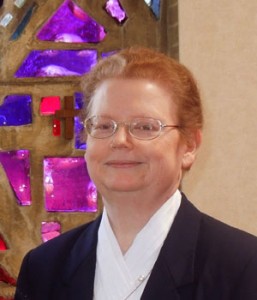
Just before the start of the new millennium ‒ August 7, 1999 to be exact ‒ I took first vows as a Sister of the Divine Savior. I was a professional single woman in my 30s, active in my parish and various social justice ministries. So why did I choose to become a Salvatorian Sister at this point in my life and at this point in the history of the province?
I felt a call to religious life. A call to make a difference, to serve those in need, to grow in my faith, and to live and work with others who shared Gospel values. In looking at a number of different congregations, I was drawn to the Salvatorians’ founding charism – to make known the Savior by all ways the Spirit inspires – and to how it was lived out in collaboration with priests and brothers of the Society of the Divine Savior, Lay Salvatorians, and our sisters in 29 countries around the world. I felt I could use my gift of professional training as an attorney to be of service. It felt like a good “fit” and that I was being led by the Spirit.
When I started my formation in 1996 the province had almost 150 sisters. I had not known the community when there were double that number, so it didn’t seem small to me. We were small enough that everyone knew each other, like a big family. Most of the sisters were older than I, many twice my age. However the community felt very much alive and the older sisters had much wisdom to share. Discernment to enter and take vows is not primarily a “head” decision, although it does offer some “data” for someone like me with an analytical bent. More so, it is a response to a felt call, to what I believe is God’s will for me at that time and place.
Click here for Sister Pat Russell’s Answer
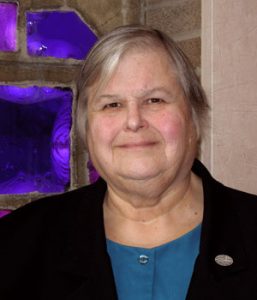
I grew up in a strong Catholic environment but no one in my family was ever a priest or sister. I moved to Arlington, Va. at age 19 and began working for the Department of Justice. I was also active in church activities, including an apostolic movement known as Cursillo. When I was 24, a friend asked me very directly when I was going to become a sister. I could not give her an answer. I thought by responding to back-page ads in religious magazines, “the pull” would go away. God had other plans.
Some things took on a whole new meaning – like songs, scripture readings, even casual comments. My one major stumbling block: I didn’t want others to relate to me as “one of them,” and I didn’t want to lose my personality. Working as a secretary, I also wondered what I would do if I joined a religious congregation. When I shared my concerns with a friend who was a priest, he said something that has stuck with me all these years. He told me I might have to give up some things, but religious life gives access to people in a very special way. People trust you with what is important in their lives and you have a chance to make a difference.
When I visited the Salvatorians I felt at home. Sister Pat Kieler, then vocation director, told me that who I am was important and what I do was secondary. The Salvatorian mission to bring God’s love to others, however and wherever the Spirit inspires is what freed me. I joined the Salvatorians when I was 26 years old. Moving from my life in Virginia to a convent in Milwaukee was challenging. Learning to live with six other women was challenging – for them and for me. So was simplifying my life, considerably. It is a journey I’m glad I made.
In the last 40 years I have had several different ministries in three different cities. I have made connections with men and women across the U.S. and around the world. I have opened myself up to others and been challenged to new growth and deeper wholeness. Oh – and I really have had opportunities to be myself with water balloon fights, camping trips, Easter egg hunts and so much more!
It was difficult whenever one of my peers chose to leave. Each time someone made that choice, I was called to search my heart and make an even deeper commitment to stay. My 26-year-old self could not have imaged the life I have now. I am very grateful God has helped me continue to answer the call to religious life from all those years ago.
Click here for Sister Barbara Reynold’s Answer
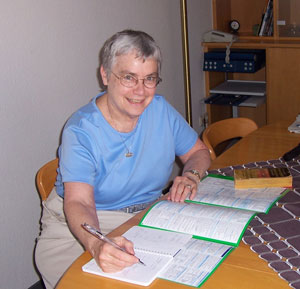
What makes me feel “at home” as a Salvatorian?
This is a mystery! When I met Salvatorian Sisters at St. Louis University, I immediately felt that each one was, as we say in Spanish, “simpatico,” meaning that in some way, our hearts met. As I was getting to know the sisters, so many of them seemed simpatico with me. Since graduate school, and particularly graduate study of mathematics, tends to develop the analytic side of our personalities, I was simply delighted to find persons who encountered me at the heart-level!
The more I got to know Salvatorians and Salvatorian spirituality, the more I felt that in some deep way I am Salvatorian. My heart was Salvatorian before I ever met Sisters of the Divine Savior. As I was preparing for perpetual vows, I had the opportunity to read some of Mother Mary’s poetry, Fr. Francis Jordan’s Spiritual Diary, and other early Salvatorian documents. Even today, as I continue studying the words of our Founders, I feel a deep recognition in my own heart, that in meeting the Salvatorians I was coming home.
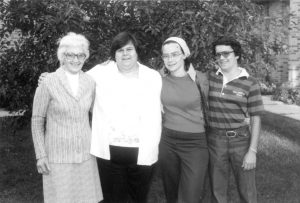
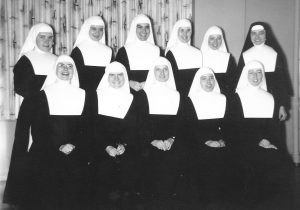
Our 125 Year Celebration
As we look back on our 125th anniversary of coming to the USA, we invite you to reminisce with us. We've launched all 5 time lines with historical milestones and stories that bring to life the experiences of our sisters who came before us.
Era 1: 1895-1920
Responding to Immigrant Needs
The missionary response of hearty immigrant women religious characterizes the first 25 years of Salvatorian Sisters’ presence in the United States ...
Era 2: 1920-1950
Expanding in an “American” Church
By 1920, life for a Salvatorian Sister in the USA was radically different than it had been 25 years earlier. World War I ....
Era 3: 1950-1970
Embracing Renewal
Bob Dylan’s 1964 classic, The Times They Are A Changing, captures the high energy of this era. Change was afoot both outside and inside the Salvatorian convent walls...
Era 4: 1970-2000
Building Collaboration
Events of the mid-1960s renewed the collaborative energy that had always characterized Salvatorian life. Cloistered living ...
Era 5: 2000-2020
Searching for New Footing in a Changing World
When the new millennium arrived on January 1, 2000, Salvatorian Sisters were already five years into our second century on USA soil. Our ...
